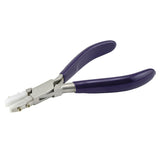These are the essential tools needed for your beginner toolbox. Many of these tools are made specifically for jewelry, and should be purchased from a jewelry supply store rather than a hardware store. Jewelry tools are generally smaller and easier to handle, and have smooth jaws that will not mar your metal.

Chain Nose Pliers
Chain nose pliers are an essential tool for jewelry making at any skill level. Use them for opening and closing jump rings, bending wire, making wire wrapped loops, closing bead tips, etc. They have smooth, flat jaws that taper to a narrow tip for getting into tight spaces.

Flat Nose Pliers
Flat nose pliers are used for many of the same purposes as chain nose, but they do not have a tapered tip. They are perfect for opening and closing jump rings, and have better grip when working with a larger surface area.

Bent Chain Nose
Bent chain nose pliers feature a smooth jaw with a tapered bent tip. They are great for opening and closing jump rings, making angled bends with wire, and working in tight spaces.

Round Nose Pliers
Round nose pliers are essential for making any kind of rounded form with wire. They have a tapered jaw that allows you to make different loop sizes. Use them for making wire wrapped loops and wrapping the ends of memory wire.

Crimping Pliers
Crimping pliers feature two notches in the jaw, one to flatten the crimp tube and create a divot, and one to fold and close it. Using crimping pliers on your crimp tubes is a very secure method for finishing necklaces and bracelets and gives your jewelry a professional look. See our crimping tutorial for a detailed guide on using these pliers.

Split Ring Pliers
Split ring pliers have one straight jaw and one bent jaw. Use them to keep split rings separated while you secure your findings.

Semi Flush Cutter
Use semi flush cutters to trim excess bead stringing wire, excess wire on headpins, eyepins, wrapped loops, etc. The angled jaw allows you to fit the tool in tight spaces for a close trim. These should only be used to cut beading wire and craft wire no thicker than 20g.

Nippers
Nippers have a more narrow head compared to the semi-flush cutter and work well in tight spaces. They are perfect for cutting beading wire, thin wire used on wire wraps, and some cords and threads.

Memory Wire Shears
Memory wire shears are made specifically for trimming memory wire, do not use regular wire cutters to cut memory wire or it will damage your tool. Memory wire shears are also great for trimming thicker wires.

Tweezers with Shovel
These tweezers may just be your most-used tool. Use them for sorting and picking up beads. They can also be used for knotting thicker threads.

Knotting Tweezers
Knotting tweezers have a very fine tip that is perfect for knotting thread. They come in both straight or bent noses.

Calipers
Calipers are a handy tool for measuring small pieces. The digital models work great for accurately measuring small beads and stones down to the hundredth of a millimeter. Most digital models can measure the inside diameter of a bead as well.
Ruler or Measuring Tape
A ruler or measuring tape is always necessary for making sure your design is the appropriate length.

Bead Stoppers
While you can always use a piece of tape at the end of your beading wire to prevent the beads from slipping off, these bead stoppers make bead stringing so much easier. The spring mechanism opens and closes easily around your beading wire and won’t leave any kinks or residue.

Bead Reamer
A bead reamer is like a rounded file that is used to make the holes larger in beads. You can also use it to clear out a clogged hole.

Nylon Jaw Pliers
Use nylon jaw pliers for shaping and sculpting wire without marring it. It also works well for straightening kinked wire.

Bead Board
Use a bead board as a workspace to lay out and measure your designs before stringing. They come in several different sizes and styles, and usually have a couple of compartments to contain your beads while you design.

Bead Mat
A bead mat is a piece of foam like fabric to use as a work surface that prevents beads from rolling around. They are great for laying out your designs or sorting beads, and can even be thrown in the wash when they get dirty.
